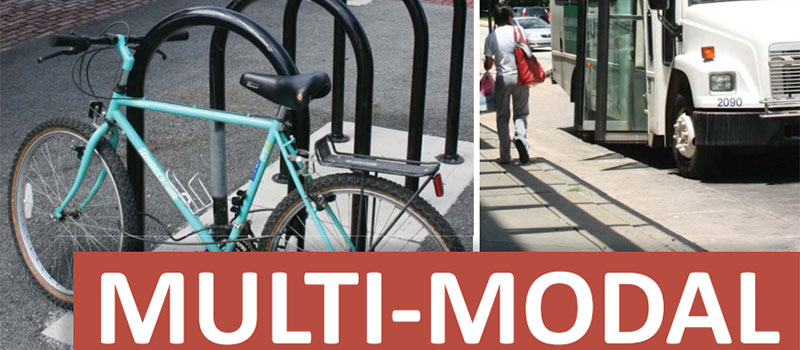Parking
Parking lots are critical linkages between the transportation system and destinations. A poorly designed parking lot that does not accommodate all modes can single handedly discourage alternative modes. A well designed parking lot can transform a development into a vibrant welcoming space.
Excess parking has many direct and indirect costs. Direct costs for developers include the purchase of additional land, improvement and added maintenance costs, and property taxes. Indirect costs to a developer, but more direct costs to the environment include heat island generation and the excess stormwater runoff and loss of ground water recharge areas created by the added impervious surfaces.
Parking availability can affect not only the destination, but also the means people will use to reach a destination. The more difficult it is to find available parking, the less likely people will drive their automobiles to a destination. Lack of available parking also makes it more likely that people will utilize public transit, if it is available and relatively convenient. If there is a consistent abundance of available parking, it may indicate the parking lot is too large.
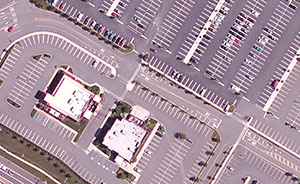
Walkways are an integral part of parking lot design.
Many off-street parking lots for commercial areas have traditionally been designed to accommodate the maximum parking loads and predominant use of single occupancy vehicles. Balancing the demands of the private sector to provide sufficient parking with the municipality's desire to reduce the harmful impacts of excess parking is an issue many municipalities must contend with in new developments.
Determining the proper size, location, and layout of parking facilities are important decisions that municipalities must make to provide the most appropriate level of parking within a municipality. Facility types generally include off-street surface parking, on-street parking, and structured parking (parking garages).
Comments
Parking facility design must reflect many factors including the amount of space available for the facility, the number of parking spaces required by the destination's land use, environmental and site specific conditions. The following provides general design principles and guidance regarding the physical elements to be addressed when developing parking facilities.
Site Work — Basic design principles to consider when deciding where parking facilities should be located include:
- Locate parking areas convenient to building entrances;
- Minimize extensive grading operations by designing with the topography;
- Slope parking areas between a minimum of 1% and a maximum of 5% ,with an ideal slope of 2%;
- Create multiple smaller parking areas rather than one large mass;
- Integrate planted islands to increase aesthetics and improve runoff collection opportunities;
- Use topography and trees to mitigate negative visual impacts;
- Minimize negative impacts on the natural environment such as the unnecessary removal of mature vegetation or compromising soil stability; and,
- Utilize rectangular parking area configurations to minimize land area requirements.
Number of Spaces — The Delaware Valley Regional Planning Commission (DVRPC) developed the publication The Automobile at Rest: Toward Better Parking Policies in the Delaware Valley, which inventories the parking standards of all Chester County municipalities and offers the following policy recommendations towards establishing a proper amount of parking spaces:
- Conduct an inventory of parking usage at various locations, times, and days to gauge whether excess parking is supplied for certain uses;
- Revisit number of parking space requirements in ordinances to ensure that required parking supply does not exceed demand and is sensitive to the local context. The following table - excerpted from SmartCode (Version 9.2), a new urbanist model transect-based unified development ordinance - suggests parking requirements for different use types across the transect of land use types ranging from rural to urban core;
- Provide alternatives to conventional parking standards by allowing by-right, flexible parking provisions such as shared parking, reserve parking, and fee-in-lieu parking; and,
- Identify areas where a unique context, such as proximity to transit or an historic village setting, indicates the need for specialized standards such as parking.
Smart Code Parking Requirements
| T2 Rural T3 Suburban |
T4 General Urban | T5 Urban Center T6 Urban Core |
|
|---|---|---|---|
| Residential | 2.0/Dwelling | 1.5/Dwelling | 1.0/Dwelling |
| Lodging | 1.0/Bedroom | 1.0/Bedroom | 1.0/Bedroom |
| Office | 3.0/1000 sq. ft. | 3.0/1000 sq. ft. | 2.0/1000 sq. ft. |
| Retail | 4.0/1000 sq. ft. | 4.0/1000 sq. ft. | 3.0/1000 sq. ft. |
Source: Table 11 - Smart Code Version 9.2
Pedestrian and Vehicular Circulation - The orientation and configuration of parking spaces must be considered early in the development process to create a safe and convenient facility:
- Circulation systems should be designed to minimize the number of conflicts between vehicular, bicycle, and pedestrian traffic;
- Pedestrian circulation should always have a higher priority than vehicular circulation;
- Rows of parking spaces should be aligned perpendicular to the facility it serves to minimize the number of pedestrian crossings of driveway aisles;
- All off-street parking facilities should be accessible without backing into or otherwise re-entering a public right-of-way;
- Customer and employee parking areas should be separated when applicable to allow for better turnover nearest the main facility entrance;
- Turning radii should be provided to accommodate the largest vehicles that will utilize the facility, such as refuse haulers, buses, and tractor trailers; See also VEHICLE CHARACTERISTICS design element.
- Parking rows should be located on each side of a driveway aisle for paving efficiency;
- End islands, whether painted or curbed, are useful in several respects. An important one is to delineate the circulation road edge. Of equal importance is providing adequate sight distance for vehicles leaving the parking aisles;
- Dead end parking areas should be avoided whenever possible; and,
- Transit stops should be sited at a central location with walkways leading to all facility entrances to achieve a balance between multimodal accessibility and transit route efficiency.
Distributor Roads - In larger commercial and office developments there should be a hierarchy of travel lanes ranging from a ring road, or distributor road to parking aisles. Providing for different types of traffic improves circulation and reduces the potential for accidents.
The distributor road which is intended to carry higher speed and higher volumes of traffic throughout the development should have wider lanes, no parking, and should directly link the parking area to the public street. Distributor roads carry traffic at speeds of 10 to 20 MPH while parking aisles function at speeds of less than 10 MPH.
The intended function of the roadway immediately adjacent to a building is to be the fire lane and pick-up/drop-off area. It should not be used as a distributor road for through traffic.
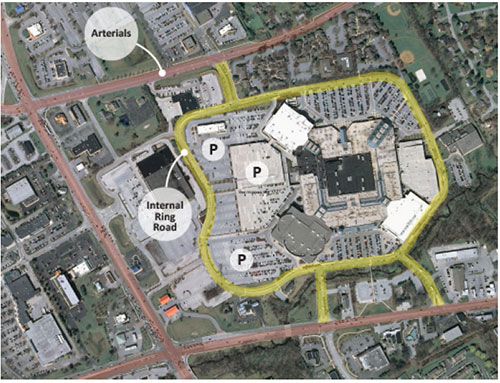
Example of an internal distributor road.
Off-Street Parking
Off-Street Parking (on-lot parking)
A space located off the public right-of-way for parking a motor vehicle.
Off-street parking is the most common type of parking facility. These facilities have traditionally been developed as one large paved area resulting in expanses of asphalt. Most of these traditional lots were developed prior to the passage of modern stormwater regulations.. Parking lot designers should limit the places where pedestrians are forced to cross vehicular traffic, and reduce redundant driveways, inefficient single stacked parking bays, locations where cars need to back into intersections, limit vehicular stops and turning movements, as well as consider appropriate locations for trash enclosure pads with regard for trash vehicle turning radii.
One of the first decisions to make when designing a parking facility is to determine the safest and most efficient configuration of the available space to meet the parking requirements. There are a number of different parking angle configurations to be considered, including perpendicular (or 90 degree) and other angled (60, 45, 30 degrees) options. The following provides basic descriptions and dimensions including the advantages and disadvantages for each configuration type:
 Perpendicular (90 degree) - This is the most efficient and economical parking configuration because it accommodates the most vehicles per square foot of available parking area. Perpendicular configurations work best with two-directional driveway aisles; one way drive aisle configurations have almost the same space requirements and offer little advantage in circulation. Standard dimensions for this configuration are 9 foot wide by 18 foot deep spaces with a 24 foot wide (two-directional) driveway aisle for a total 60 foot wide cross section.
Perpendicular (90 degree) - This is the most efficient and economical parking configuration because it accommodates the most vehicles per square foot of available parking area. Perpendicular configurations work best with two-directional driveway aisles; one way drive aisle configurations have almost the same space requirements and offer little advantage in circulation. Standard dimensions for this configuration are 9 foot wide by 18 foot deep spaces with a 24 foot wide (two-directional) driveway aisle for a total 60 foot wide cross section.
Advantages
- Handles the most vehicles per square foot of available space
- Handles most vehicles per linear foot along a driveway
Disadvantages
- Requires the widest dimension (60 ft) for a double bay
- Difficult maneuvering for some drivers compared to other angled options
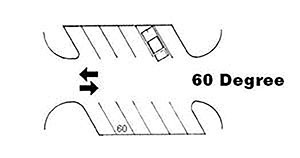 Angled—60 Degree - The primary advantage with any angled parking is the ability to provide more spaces or better circulation patterns when the space available for parking is dimensionally constrained. The 60 degree angled parking configuration is ideal for a fast turnover rate or predominantly short term use and may be preferred over 90 degree parking in some situations due to ease of navigation, even though it may be a less efficient use of the available space. Standard dimensions for this configuration are 9 foot wide by 20 foot deep spaces with a 24 foot wide (two-directional) driveway aisle for a total 64 foot wide cross section, or 16 foot wide (one-directional) driveway aisle for a total 56 foot wide cross section.
Angled—60 Degree - The primary advantage with any angled parking is the ability to provide more spaces or better circulation patterns when the space available for parking is dimensionally constrained. The 60 degree angled parking configuration is ideal for a fast turnover rate or predominantly short term use and may be preferred over 90 degree parking in some situations due to ease of navigation, even though it may be a less efficient use of the available space. Standard dimensions for this configuration are 9 foot wide by 20 foot deep spaces with a 24 foot wide (two-directional) driveway aisle for a total 64 foot wide cross section, or 16 foot wide (one-directional) driveway aisle for a total 56 foot wide cross section.
Advantages
- Easy maneuvering in and out of parking spaces due to better visibility
- Lends itself to either one-or two-way aisles
- Works best with short term and high turnover situations
Disadvantages
- Requires more pavement per vehicle than perpendicular configurations
- Handles fewer vehicles per linear foot
 Angled—45 Degree - The 45 degree angled parking configuration displays similar benefits and limitations as the 60 degree configuration. Standard dimensions for this configuration are 9 foot wide by 19 foot deep spaces with a 14 foot wide (one-directional) driveway aisle for a total 52 foot wide cross section. Two-directional driveway aisle dimensions are not provided since two-directional 45 degree parking requires almost the same amount of cross section width as 90 degree configurations while providing significantly fewer spaces.
Angled—45 Degree - The 45 degree angled parking configuration displays similar benefits and limitations as the 60 degree configuration. Standard dimensions for this configuration are 9 foot wide by 19 foot deep spaces with a 14 foot wide (one-directional) driveway aisle for a total 52 foot wide cross section. Two-directional driveway aisle dimensions are not provided since two-directional 45 degree parking requires almost the same amount of cross section width as 90 degree configurations while providing significantly fewer spaces.
Advantages
- Reduced width requirements
- Easy maneuvering in and out of parking spaces
- Good rear visibility
Disadvantages
- Does not work well with two-way aisles
- Requires more pavement per vehicle than both 90 and 60 degree parking configurations
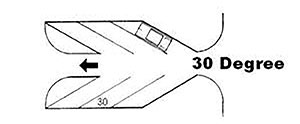 Angled—30 Degree - Similar to 45 degree configurations, this configuration progressively increases the amount of pavement required per space while narrowing the double bay cross section. Standard dimensions for this configuration are 9 foot wide by 16.5 foot deep spaces with a 12 foot wide (one-directional) driveway aisle for a total 45 foot wide cross section.
Angled—30 Degree - Similar to 45 degree configurations, this configuration progressively increases the amount of pavement required per space while narrowing the double bay cross section. Standard dimensions for this configuration are 9 foot wide by 16.5 foot deep spaces with a 12 foot wide (one-directional) driveway aisle for a total 45 foot wide cross section.
Advantages
- Easiest spaces to back out from a visibility standpoint
- Least required width for double bay cross section
Disadvantages
- Requires the most pavement per vehicle parking space
- Does not work well with two-way aisles
Landscaping - The most attractive,most functional, and most sustainable parking areas are those that are well landscaped. Trees provide valuable additions to parking areas, whether planted in curbed islands or located on the parking area perimeters. Trees provide shade, visually reduce the mass of open pavement, and mitigate heat gain. Landscaped areas may be used to collect runoff for stormwater management. The following are some general considerations for how plant materials can be used to improve parking facilities:
- Provide internal parking islands to break up large expanses of paving and reduce the heat island effect;
- Provide appropriately-scaled, well-graded and planted earthen berms or mounds around parking area perimeters to screen the parking area from streets and other facilities; and,
- Minimize the use of medium to tall shrubs on internal curbed parking islands to allow for greater visibility within a parking area
Other factors to consider:
- Parking areas are not conducive to healthy plant growth due to reflected sunlight, heat gain, and exhaust fumes. Only plant species that are tolerant of these extreme conditions should be used.
- Non-porous pavement limits the oxygen and water exchange between plant roots and the atmosphere. Soil compaction resulting from construction amplifies these conditions for existing trees. Consider the use of porous pavements and existing tree protections during construction of these facilities to promote plant health.
- Curbing should be used for planted islands where appropriate to protect against trunk damage created by vehicles.
- In addition to providing curbing and/or bumper blocks, ensure that parking spaces provide sufficient separation from trees and shrubs to avoid damage.
- Native plant species should be selected whenever possible.
- Clear sight distance should be provided at all intersections/driveway entrances. Low level plantings in parking islands should remain low and not destruct sight lines within a parking lot.
Avoid the following with respect to tree plantings:
- trees with messy fruits or berries;
- brittle-limbed species;
- spreading root systems;
- large leafed deciduous trees that can clog drains and make walking hazardous; and,
- trees susceptible to insects and diseases.

A good example of trees and planted
islands within a commercial parking lot.
Trees that should be selected include those that:
- cast medium to dense shade in summer;
- have normal life spans over 60 years;
- thrive in pollution and in the heat of a typical urban environment;
- demonstrate salt and de-icing compound tolerance;
- require little pruning and are structurally sound; and
- are resistant to insects and diseases.
See also LANDSCAPE MATERIAL design element.
Lighting - Lighting is an important component of parking lot safety, especially for a facility that has early morning, late afternoon, or night time use. The Illuminating Engineering Society (IES) recommended minimum average illumination level for a surface parking lot is 0.5 footcandles. The IES also recommends that all pedestrian routes and entrances/exits should be well lit with a minimum average of 1.0 footcandles. Lighting poles are typically 20-25 feet in height, and should be located in islands or in parking perimeters and protected from potential vehicular damage.
Other lighting factors to consider include:
- Lights should be pointed downward to minimize light pollution and excess glare. Cutoff fixtures should be used to avoid light spilling onto neighboring properties.
- Bulb selection will affect the color of light projected. High pressure sodium bulbs are relatively inexpensive, yet cast an orange hue while more expensive metal halide bulbs cast more of a white light.
- LED fixtures are now becoming more widely used as the technology for these fixtures has advanced to provide much brighter fixtures. The energy required to power LED fixtures is considerably less than standard bulbs resulting in significant cost savings.
See also LIGHTING design element.
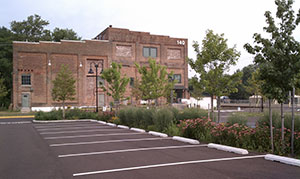
Example of vegetated bioswales within parking islands
at Riverfront Park, Pottstown, PA.
Stormwater Management - Surface parking lots have traditionally been developed with large expanses of asphalt resulting in a significant increase in stormwater runoff. The stormwater was then collected by a drainage system where runoff from large storm events would be temporarily stored in a retention basin then slowly released through control structures into the natural drainage systems. This general concept has been revised and reflected in Pennsylvania through the State's adopted erosion and sediment control regulations where the focus is to infiltrate or recharge a much larger portion of this runoff into the ground. As part of this shift, the National Pollutant Discharge Elimination System (NPDES)-as authorized by the federal Clean Water Act-now requires a permit for any earth disturbance exceeding 1 acre, where the threshold was previously 5 acres. These permit applications are reviewed by the local Conservation District as part of the land development process.
To help facilitate these new regulations, the state has published the Pennsylvania Stormwater Best Management Practices Manual. Some examples of Best Management Practices (or BMPs) applicable to surface parking include:
- Pervious Pavement with Infiltration Bed
- Infiltration Basin
- Subsurface Infiltration Bed
- Infiltration Trenches
- Rain Garden/Bioretention Areas
- Vegetated Swales and Filter Strips
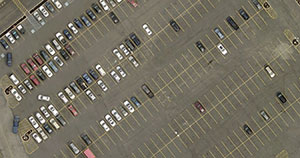
Parking lot with a large expanse of uninterrupted paving.
Shared Use Parking - 'Shared Use' parking is the approved use of the same off-street parking spaces for two (2) or more uses where peak parking demand of the different uses occurs at different times of the day, or, where various uses are visited without moving the automobile; and, where the division of parking spaces is a net decrease from the combined total of individual off-street parking requirements for each use.
Municipalities should consider possibilities for shared parking facilities based on operating hours and peak parking times for adjacent or nearby uses. Through the use of shared parking facilities, a lower overall number of parking spaces may be justified. Municipalities should be assured that adequate parking facilities for all uses will continue in the long-term and be available regardless of individual land use changes.
Areas where excess parking is provided should be considered for use as a park and ride facility for public transportation. See also the PARK-AND-RIDE design element.
On-Street Parking
On-Street Parking (Parking Lane)
An area within the right-of-way and adjacent to the travel lane for parking motor vehicles.
Standards
AASHTO: The minimum width of a parking lane is 8 feet. The desirable width is 10 to 12 feet.
PennDOT:
- Arterial: Ten foot minimum, 12 feet desirable, 9 feet if used as a turning storage lane and average running speed is less than 40 MPH. Eight feet is acceptable if that lane will not be used as a traffic lane in the foreseeable future.
- Collector: Seven to 10 feet on both sides with two 11-foot travel lanes. Eight to 10 feet in commercial and industrial areas.
- Local: Seven to 10 feet on both sides with one 10-foot travel lane, depending on lot size and intensity of development. The desirable minimum is 8 feet.
- Standard dimensions for on-street parallel parking spaces are 8 feet wide by 22 feet long and placed at least 50 feet from any intersection.
See also the LANE DESIGN design element
Comments
It can generally be stated that on-street parking decreases through capacity, impedes traffic flow and increases accident potential (AASHTO). From a comprehensive review of accident data, curb parking is directly or indirectly responsible for at least one out of every five accidents that occur on surface streets in our cities each year (ITE). While this applies to the nation's urban centers it must be taken into account when designing on-street parking anywhere.
The type of on-street parking selected should depend on the specific function and width of the street, the adjacent land use and existing and anticipated traffic volumes.
On-street parking is most commonly associated with urban or village landscapes and is often metered as a revenue generator as part of a community's parking management program. On-street parking spaces are typically included in the design of the roadway within which they are located and also referred to as 'parallel' parking.
On-street angled parking is less common and often associated with historic or central business districts with lesser traffic volumes where it also serves as a traffic calming effect. These installations require much more space within the road right-of-way than parallel parking but offer the opportunity to create more stalls within the same length.
Back-in angled on-street parking has recently been installed in the Borough of Pottstown, Montgomery County, PA. This installation on East High Street converted two westbound travel lanes and on-street parallel parking into one westbound lane, one bike lane and back-in angled parking within the same available space. Installed in 2003, this concept "has helped revitalize the downtown by slowing traffic, providing more parking spaces adjacent to stores, encouraging bicycling, and making it easier for pedestrians to cross the street."
ADA Accessibility & Parking Requirements
ADA Accessibility & Parking Requirements (aka Handicapped parking and access)
All or any portion of buildings, structures, site improvements, complexes, equipment, roads, walks, passageways, parking lots, transportation facilities, or other real or personal property that are readily accessible to and usable by individuals with disabilities in terms of architecture and design, transportation and communication.
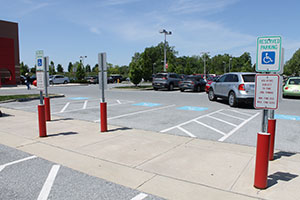
ADA accessible parking.
The Americans with Disabilities Act (ADA) Accessibility Guidelines for Buildings and Facilities requires that the construction of all new facilities shall provide at least one accessible route within the boundary of the site from public transportation stops, accessible parking spaces, passenger loading zones if provided, and public streets or sidewalks, to an accessible building entrance. And, at least one accessible route shall connect accessible buildings, facilities, elements, and spaces that are on the same site. The accessible route shall be a minimum of 36 inches wide. The routes should be as close to the designated handicapped parking spaces as possible. See also the ADA ACCESSIBILTY design element.
The minimum number of accessible parking spaces to be provided is based on the total number of spaces included:
| Total number of parking spaces provided in parking facility | Minimum number of required accessible parking spaces |
|---|---|
| 1 to 25 | 1 |
| 26 to 50 | 2 |
| 51 to 75 | 3 |
| 76 to 100 | 4 |
| 101 to 150 | 5 |
| 151 to 200 | 6 |
| 201 to 300 | 7 |
| 301 to 400 | 8 |
| 401 to 500 | 9 |
| 501 to 1000 | 2% of total |
| 1001 and over | 20, plus 1 for each 100, or fraction thereof, over 1000 |

Source: ADA Accessibility Guidelines for Buildings and Facilities
Accessible parking spaces serving a specific facility should be located closest to an accessible entrance. If facilities have multiple accessible entrances, accessible parking spaces should be dispersed and located closest to the accessible entrances.
Accessible parking spaces should be at least 8 feet (96 inches) wide. Parking access aisles should be part of an accessible route to the facility entrance. Two accessible parking spaces may share a common access aisle at least 5 feet wide, with the potential for the aisle to be 8 feet minimum width if shared with accessible van parking. Parked vehicle overhangs should not reduce the clear width of an accessible route. Parking spaces and access aisles should be level with surface slopes not exceeding 1:50 or 2% in all directions. Signing for parking spaces should be placed on the paving surface and meet the requirements of the law.
Structured Parking
Structured Parking (parking garage)
A building constructed primarily to provide for many levels of off-street parking to meet high parking demands.
Parking garages are most commonly associated with densely developed urban centers and represent a significant investment in providing for a parking facility. They may also be developed at locations that have a significant draw with little or no additional space available to provide for more surface parking to meet the parking demands. Examples of such locations include transportation centers, rail stations, shopping malls & centers, and significant employment centers.
There are many design factors to consider for structured parking, including:
- The size and shape of the lot where the structure will be developed.
- Who the primary users of the facility will be.
- Connections to the adjacent street network.
- The architectural style of the structure's facades and how they may relate to existing adjacent structures.
- A municipality may also look for shared use opportunities-SEPTA's West Chester Transportation Center was incorporated into the newly constructed parking garage developed by Chester County across from the Justice Center on Market Street.
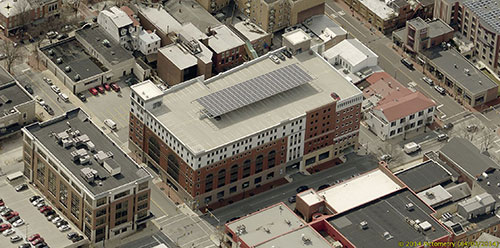
West Chester Borough's Chestnut Street parking structure with Solar Array.
Recommendations
- Recommend use of ITE's, Parking Generation and Guidelines for Parking Facility Location and Design: A Recommended Practice as a starting point to establish parking requirements. Requirements of adjoining uses should be considered for possible sharing.
- Follow the recommendations of the DVRPC publication The Automobile at Rest: Toward Better Parking Policies in the Delaware Valley, to further refine the actual parking demand and number of spaces to be provided for the proposed use.
- Trees and other landscape materials should be provided for all off-street parking lots. A good ratio for determining the appropriate number of trees would be one tree for every 3-5 parking spaces required. Landscape materials should be planted so as to not interfere with required clear sight distances at plant maturity.
- Adequate lighting should be provided in parking lots for facilities with night time uses to ensure safety and security. Cutoff fixtures should be used to avoid light pollution and spillage onto adjacent uses. Energy efficient bulbs should be considered for long term cost savings.
- Developers and municipalities should utilize stormwater BMPs such as porous pavement, planted islands, rain gardens, and others whenever possible to reduce and infiltrate stormwater runoff.
- Permit shared use parking facilities which may reduce the number of required parking spaces and associated impervious coverage. Shared parking is particularly useful when two land uses have different peak parking demands.
- Residential parking should be off-street whenever possible. Streets bordering large lots do not require on-street parking because vehicles are accommodated on the property while streets bordering smaller lots usually require some form of on-street parking.
- Follow the regulations of the Americans with Disabilities Act Accessibility Guidelines for Buildings and Facilities (chapter 2, section 208); and, Transportation Facilities (Chapter 5, section 502)
- Municipalities that need to provide structured parking should consider not only the development costs but also the long term operation and management of such a facility.


